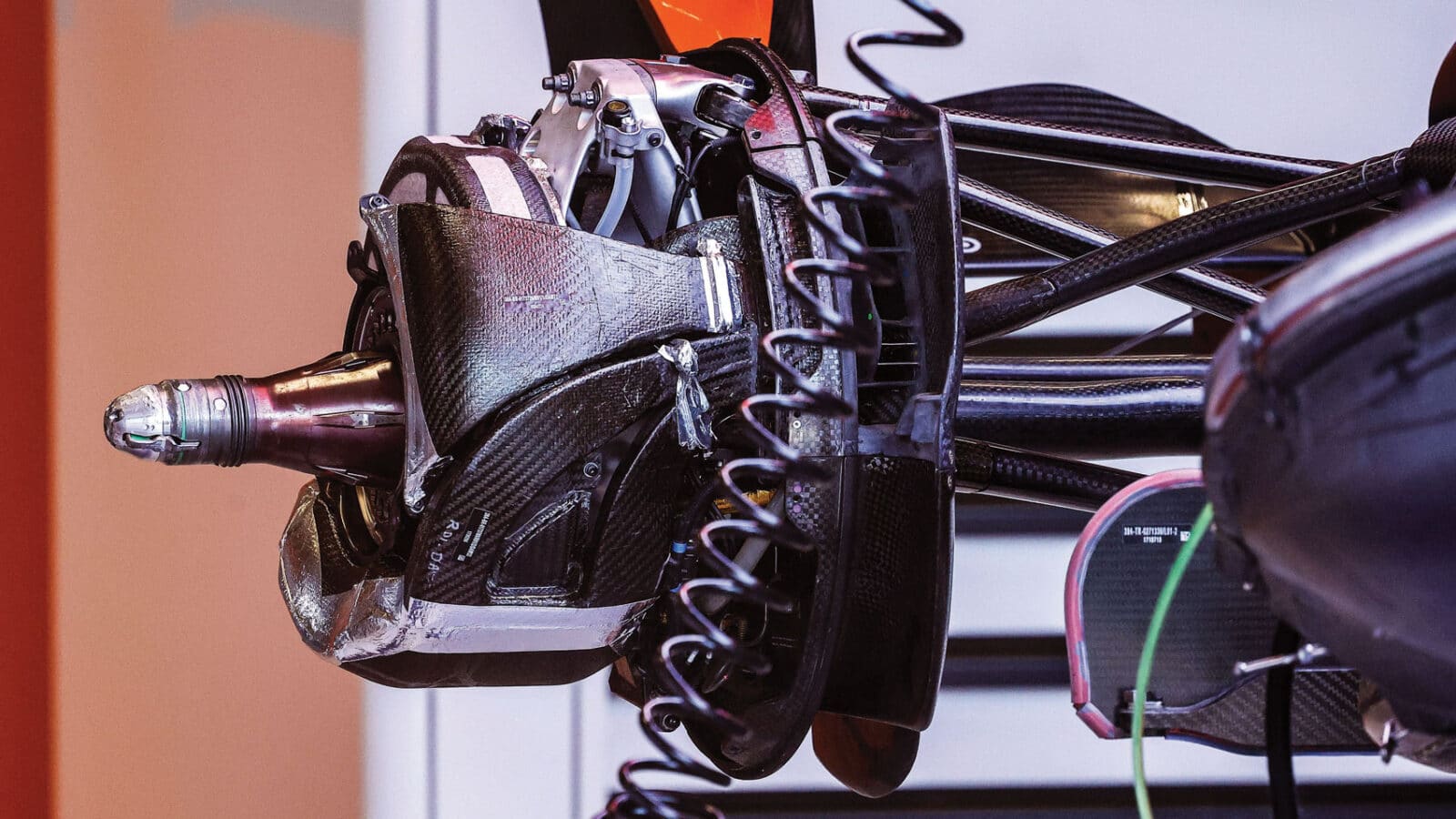Did McLaren design error lead it to F1 success?
A flawed McLaren brake duct left it stuck in the pits in 2022. Did it bizarrely lead to the car’s current superiority?

A close up of the rear brakes of the MCL39 taken at Imola which have been under intense scrutiny by rival teams
DPPI
Sometimes in F1 when a technical problem is encountered, the learning taken from it can be competitive gold dust. McLaren’s current rear brake duct design has been the focus of intense scrutiny from rival teams as the car’s ability to keep its rear tyres cool when everyone else’s are overheating has been a crucial part of its sometimes-dominant performances.
“No one outside the team and the FIA knows how the ducts work”
Brake duct design has become incredibly sophisticated and those of the McLaren are the most sophisticated of all. No one outside the team and the FIA (which has inspected them closely) knows exactly how the internal channels are routed in a way which is so effective at keeping excess temperature out of the wheelrims and therefore the tyres. Thermal images captured by a rival team at a McLaren pitstop confirmed how much cooler they are able to run. As with any other brake duct, there’s an air inlet and an outlet, but what happens in between is where the magic lies.
It’s further complicated by the regulation standard supply carbon fibre ‘cake tin’ which encases the disc and forms part of the whole duct arrangement. Everyone has the same cake tins but the McLaren’s are evidently running cooler than the others. What appear to be pressure sensors are affixed to the ducts in practice and these may offer a clue. The difference between external ambient pressure and that inside the cake tins will determine the speed of the flow. The lower the pressure, the higher the flow speed.
The relationship in area between the duct’s inlet and outlet will play a big part in determining what that pressure is, but the routing in between could amplify the effect. Furthermore, the McLaren outlets are not simply a single box as on other cars but have compartments, created by vanes, suggesting an adjustability based upon how much air is needed to cool the brakes and therefore how much can be used to cool the rims.
Whatever the crucial feature is, it’s highly effective and McLaren clearly has a fuller understanding of the flow behaviour than other teams. Rewind three years to the beginning of 2022 when McLaren was unable to run consecutive laps in Bahrain testing because of a design flaw in its front brake ducts.
The technical director at the time, James Key, said the following: “We had not quite enough cross-sectional area in the exit ducts for the very energised, high temperature air to always guarantee it was going to pass through. In some situations we were even finding the flow reversed. Even though we had gone through the standard process of proving the cooling would be OK, what we concluded in Bahrain was a) the brake energies were higher than predicted and b) we had been right on the edge but didn’t know it – and that’s where we really made the mistake. We’d seen them running slightly high in Barcelona but just reasoned that away.
“It was a failure on our part, a failure of process. At a certain air temperature, in certain circuit conditions with a certain exit configuration we discovered you could choke the whole system.”
Did the research into understanding and correcting that problem send the team in a direction which has resulted in its current mastery of the technology? It wouldn’t be the first time a technical faux-pas pointed a team in a very fruitful direction it would not have otherwise followed.
Back in 2001 Renault produced a radical new engine with an extremely wide (111-degree) vee angle between its two banks of five cylinders. Not only would the resulting lower rear deck bring aerodynamic benefits by improving flow to the rear wing, but the lower centre of gravity compared to the conventional 72, 80 and 90-degree engines around at the time would give the tyres an easier time.
What happened instead was that the vibrations created by the unusual vee angle were so great that the revs had to be restricted (limiting the power) and the engine beefed up (making it heavier). Where this bandage solution led was very interesting – and would in time form the basis of the team’s 2005 and ’06 world titles.
Because the revs at which the engine could safely run were restricted, the team then sought to improve the torque curve, optimised around the new lower rev limit. This eventually endowed the motor with superb low-speed power delivery and a reduction in fuel consumption. Couple that with a more rearwards-biased weight distribution (because of the heavier engine) which more fully exploited the superb longitudinal performance of the Michelin tyres, and the car had great performance off the line and out of slow turns.
Although the 111-degree engine was quickly discarded and replaced by a more conventional V10 (and for 2006 a V8), the new engines retained the emphasis on low-speed torque and the cars were conceived with a deliberately more rearward weight bias than its rivals. Now competitive on power but with better fuel efficiency and traction than the competition, they won titles with Fernando Alonso.
They would never have sought to go in that direction had it not been for the dud 111-degree engine. Seems like McLaren may have followed a similar path.
Paddock talk
“He needs to be fast, not crash and score points”
Flavio Briatore on his expectations for young driver Franco Colapinto at Alpine. Simple
“We’re west Norfolk people so plenty to talk about”
Kings Lynn local Martin Brundle on his chat with Sandrigham resident King Charles while receiving his OBE
“It is insane. For me it is the best part of it”
Carlos Sainz is impressed with the in-car camera footage of the new F1 movie after drivers were given a private screening in May
“I’m still a human and I still have emotions”
Oscar Piastri addresses his cool, calm and collected reputation ahead of the Monaco GP
“For me, I was in the midde of nowhere”
Lewis Hamilton after finishing fifth at Monaco reflects on his ‘unclear’ team instructions as his Ferrari difficulties continue

